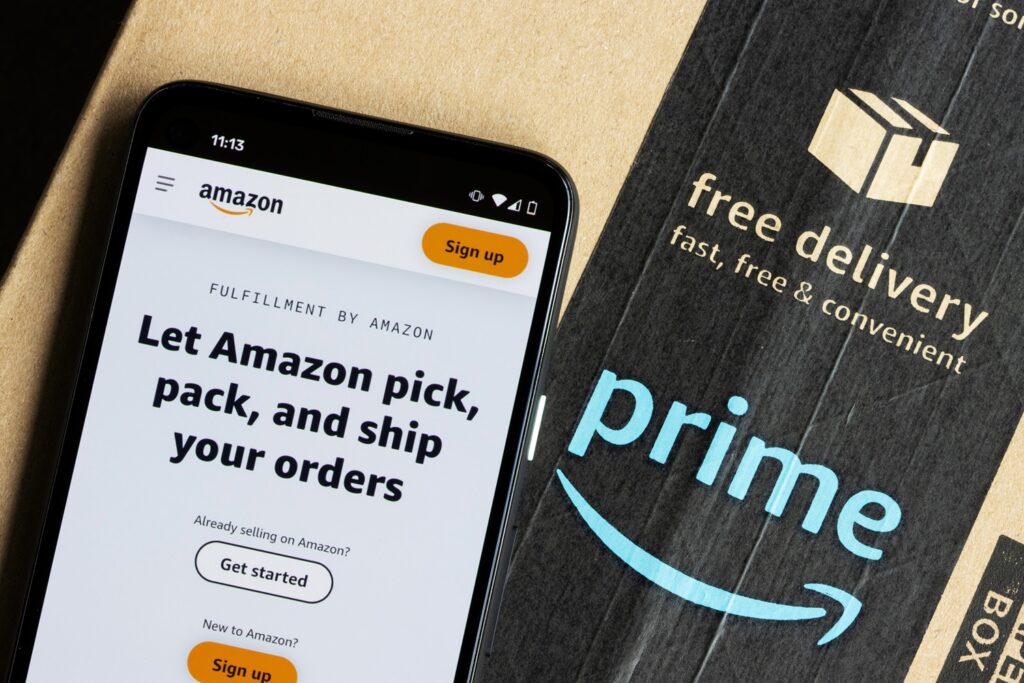How Does Amazon Advertising Work? A Complete Guide

Nowadays, Amazon advertising is essential for any seller in the e-commerce competition, as it aims to increase product visibility and sales. More than a hundred million customers come to Amazon daily, and taking advantage of the advertising can massively boost your reach.
Our guide covers all things Amazon advertising — what it is, how it works, the different types of ads and why any seller would want to use them. Below, you will learn everything about Amazon ads and how to dominate in the ever-evolving eCommerce world, whether it is your first time on Amazon or you’re looking for ways to refine your strategy.
What is Amazon advertising?
Amazon advertising is an invaluable resource for those looking to get their products out in the midst of millions of potential customers already using Amazon and searching daily. This ad service includes options of different types, depending on your specific marketing goals and budget.
Sponsored Products ads are keyword-targeted ads that appear within Amazon search results and on product detail pages. These ads increase visibility for individual products and assist in boosting the sales of a particular item.
Sponsored Brand ads display a brand logo, custom headline, and multiple products. This is where ads are shown at the very top of search results, building up brand awareness with a separate landing page or an Amazon storefront.
Sponsored Display ads, on the other hand, target shoppers with and without purchase intent in Amazon-like marketplaces where Sponsored Brands ads appear. These ads will be shown on product detail pages, customer reviews pages, and more broadly throughout Amazon inventory so you can retarget people who have considered similar types of products.

How does Amazon advertising work?
The process Amazon advertising follows is as simple yet effective, allowing the sellers to promote their products to an audience that has always been in need of your product. Here, you can understand how it works step by step:
1. Choose your ad type: For starters, you want to choose an ad type that compliments your marketing objective. There are Sponsored Products, Sponsored Brands, and then, just to make it more complex for you, they have now introduced Sponsored Display ads, each offering slightly different benefits. If your objectives are sales, drive that with Sponsored Products; if you want more brand visibility, then leverage Sponsored Brands; or if you’re just retargeting and advertising off Amazon, use those dollars for Sponsored Displays.
2. Creating a campaign: Open the Amazon advertising console on your browser and create a new campaign. The campaign type you select will depend on the ad format you choose. You must manually initiate a product campaign for Sponsored Products, a brand one for Sponsored Brands, and a Sponsored Display campaign.
3. Bidding strategy and budget: Amazon ads work on a cost-per-click (CPC) model, which means that you only pay when the shoppers click your ad. Then, you will be allowed to set the promotion name and schedule it with a start date and end date (optional), as well as a daily budget or lifetime budget if applicable. You may also select automatic bidding, where Amazon will adjust your bid to win placements or manual bidding, in which you must enter the maximum amount you are willing to pay per click. It helps your overall performance and also decides where to place an ad.
4. Choose targeting options: Picking the right targeting is key to getting your ads in front of an ideal audience. Sponsored Products and Brands will enable you to target keywords (you choose the terms shoppers might use when searching for your products) or product targeting, which consists of choosing individual products or categories to place bids on. With Sponsored Display ads, you can target your audience by shopper interests and behaviours or retarget previous visitors to your product detail pages.
5. Creating your ad: Sponsored Products will create the ad for your based on your product listing. Sponsored Brands allow you to bid on custom headlines and select the products that will be featured. Sponsored Display ads involve setting up creatives and targeting parameters, and they can appear on Amazon’s site or across its network.
6. Monitor and optimise your campaign post launch: After you have launched your campaign, regularly track the performance through the Amazon advertising console. Always keep a tab of key metrics that measure the number of impressions, click-throughs and actual signups/conversions. Leverage this data to optimise your campaign by optimising bids, honing in on targeting, and updating ad creatives for better performance metrics while driving towards the objectives you defined in your marketing goals.

Why Amazon advertising is important for sellers
There are many advantages for Amazon sellers focusing on product visibility and increasing sales using Amazon advertising. These are the reasons it becomes a must for your e-commerce strategy:
- Targeted reach: Amazon ads put your products in front of millions of shoppers who are actively looking for the items you sell and ready to buy. By maintaining a targeted focus, you are able to ensure that your advertising dollars go directly into the eyeballs of consumers who have displayed interest in similar items.
- Enhanced visibility: Amazon ads increase your product’s visibility on the world’s largest e-commerce site. Sponsored Products appear in search results and on product detail pages, Sponsored Brands feature your products at the top of search results, and Sponsored Display ads reach shoppers both on and off Amazon. This heightened visibility helps drive more traffic to your listings and increases the likelihood of conversions.
- Cost-effective advertising: Through Amazon’s Pay Per Click (PPC) model, you only pay when your ad gets a click from the shopper. This performance-based model makes it affordable to keep costs at a controlled level and spend your ad budget with optimisation. In addition, Amazon has an extensive suite of analytics and reporting tools that show how your campaigns are performing so you can optimise accordingly to maximise ROI.
- Competitive advantage: Since Amazon Advertising helps you target people in the buying stage of their customer journey, it offers a unique opportunity over other advertising platforms like Google Ads or Facebook Ads. While Google Ads go after users through web search queries, and Facebook ads centre around demographics and interests, Amazon leverages purchase intent by placing your products in front of people who actively want to buy.
- Integration with sales data: Since Amazon is an ad platform and a retailer by nature, it can successfully track the performance of ads over sales metrics. Such a move allows sellers to understand the impact of their ads on sales, helping them tweak strategies and fine-tune campaigns for better outcomes.

Types of Amazon ads
Amazon Advertising offers several ad formats to help sellers reach their target audience effectively. Here’s an in-depth look at the three primary types of Amazon ads: Sponsored Products, Sponsored Brands, and Sponsored Display.
Sponsored Products
Sponsored Products, which are single-product ads focusing on getting a boost in visibility. These ads show up on Amazon search results and product detail pages, which is very effective for sending traffic to your listings.
- How they work: Your Sponsored Product ad may show up in search results or on a competitor’s product page when someone searches for any keyword related to your type of product. The ad is created by default according to your product listing and represents the title, image and price of a particular product.
- Targeting options: You can choose between automatic and manual targeting. Automatic targeting allows Amazon to match your ad with relevant search terms based on your product’s information, while manual targeting lets you select specific keywords or product categories to target.
- Best use cases: Sponsored Products are great for single-item sales — especially new items or seasonal deals. They are also beneficial when you have products that rank well in a competitive category.
Sponsored Brands
Sponsored Brands (formerly Headline Search Ads) are for building brand awareness, affecting the top of the funnel. The ads show at the top of search results and include your brand logo, a customised headline and several products.
- How they work: With Sponsored Brand ads, consumers are sent to a landing page or storefront that showcases your branding and product range. This format offers a high-visibility placement that seizes the shopper’s attention and guides them into a thoughtful experience.
- Targeting options: Sponsored Brands rely on keyword targeting to match your ad with relevant search terms. Additionally, you can also assign promotions to certain items or types of products if necessary for better targeting.
- Best use cases: These ads are effective for building brand awareness, promoting multiple products simultaneously, and driving traffic to a brand’s dedicated landing page. They are especially useful for brands looking to enhance their presence and showcase a range of products.
Sponsored Display
Sponsored Display ads are intended to obtain targeted shoppers on and off Amazon. They expose your products or services to users who have displayed an interest in similar goods, categories and/or content.
- How they work: Sponsored Display ads can be published on product detail pages, customer review pages and across Amazon’s display network. Via audience targeting, they serve ads based on shopper behaviours and interests, utilising tactics such as retargeting visitors who have interacted with your product listings before.
- Targeting options: This ad format enables several targeting options, such as audience targeting to select users with similar interests and buying behaviours, product targeting for appearing on searches related items that are found in your listings or retargeting past visitors.
- Best use cases: Sponsored Display ads work best for targeting customers who might already have shown some interest in your products but haven’t yet made a purchase or as part of the retargeting process. They can also be beneficial for improving visibility on Amazon and off, building brand recognition, and prompting conversions.

Do Amazon ads work? Success stories and statistics
- Case study: Anker Innovations
Anker Innovations, a popular electronics brand, reported a significant increase in sales through Amazon’s Sponsored Products. They optimised their campaigns and saw a 25% increase in sales for their promoted products, alongside a 60% increase in the return on ad spend (ROAS).
- Case study: S’well Bottle
The S’well Bottle brand used Amazon Sponsored Brands and achieved impressive results, including a 42% increase in brand sales and a 50% higher click-through rate (CTR) compared to their previous campaigns. This success was attributed to enhanced visibility and improved targeting strategies.
Statistics:
- Amazon’s internal data: According to Amazon’s own data, advertisers using Sponsored Products see an average of 30% higher sales for the products they promote compared to those that are not advertised.
- Industry research: A 2023 report by eMarketer found that Amazon Ads have an average conversion rate of around 8.5%, which is significantly higher than many other digital advertising platforms.
Common challenges and how to overcome them
There are numerous challenges that businesses face with Amazon ads, such as the high costs and congested competitive nature.
- If advertising has become more expensive than you can handle, adjust your bid strategy around top-performing keywords and performance data.
- Use negative keywords to save your money from being spent unnecessarily on unrelated searches.
- It is tough out there, so give your product listings that extra something special: compelling images and descriptions.
- Monitor ad performance and update your targeting options to find the most relevant group.
These techniques will not only make your ad effective but also bring good results for you within the budget.

Conclusion
Amazon advertising is a powerful tool for boosting product visibility and driving sales on one of the world’s largest e-commerce platforms. You can create targeted campaigns that enhance your reach and effectiveness by understanding the different ad types—Sponsored Products, Sponsored Brands, and Sponsored Displays. While challenges like high costs and competition exist, strategic optimisation can help you overcome these hurdles.
For expert assistance in navigating and maximising the potential of Amazon advertising, contact Mercatus. Our team is ready to help you develop and execute a successful advertising strategy tailored to your business goals.


